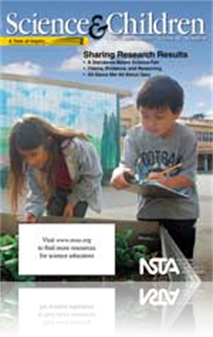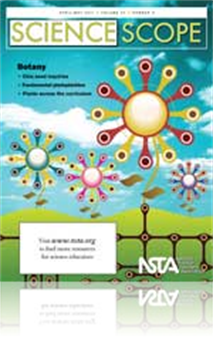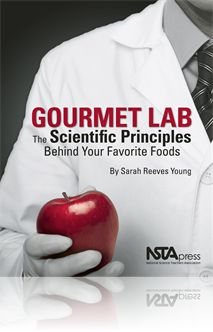All Resources
Journal Article
Explaining Electrical Circuits
A unit designed to help fourth graders explain (in writing) scientific concepts they learned through inquiry activities and explicit teaching....
Journal Article
Science Shorts: Weather Watchers
A unit that emphasizes sensory observation, with the creation of appropriate weather instruments and models!...
Journal Article
An online collaborative investigation of Brassica rapa (Wisconsin fast plants) by fifth-graders during a unit on the life cycle of plants....
Journal Article
Get in the Game With Team Density
A floating bowling ball? No way! There is no better way to get students' attention and reinforce the need for conceptual understanding than with a discrepant event like this. Density is a central concept in chemistry and physical science from middle ...
Journal Article
Teachers incorporate plants into the curriculum to learn about various subjects in addition to botany. Students use web-based resources, such as the Human Flower Project website, to explore the world of plants....
Journal Article
The New Teacher's Toolbox: Piloting New Ideas—The Brown-Bag Friday Seminar
One of the most exciting things about beginning a teaching career is developing your own ideas. Piloting new lessons is key to establishing a solid curriculum—though the process is often time-consuming and requires much reflection. In this month's ...
Journal Article
Claims, Evidence, and Reasoning
Fifth graders design and test strategies regarding levers to better their construction and justification of claims. ...
Journal Article
Editor's Corner: Private Worlds
Every time we teach, new concepts compete with students' misconceptions. It is only by identifying and examining these naive ideas that we can hope to bring about conceptual change. In this month's Editor's Corner, Field Editor Steve Metz advocates f...
Journal Article
Journal Article
Ch-Ch-Ch-Chia Seeds for Inquiry
Students learn about growing plants while using chia seeds during science inquiry activities. Nutrition and cultural history are also incorporated into the activity....
Journal Article
Elementary students must be challenged to ask good questions and develop inquiring attitudes. A well-known paper towel investigation gains new life and prepares students for their middle and high school years....
Journal Article
What's So Special About Plants? Inquiry in the Classroom
Raise student awareness of plants with these simple investigations that develop students' various process skills. Students observe plants and record these observations in their journals, design and conduct investigations, and make models....
Journal Article
Safer Science: Live Animals and Dissection
Responsible Use of Live Animals and Dissection in the Science Classroom, one of NSTA's position statements, emphasizes the role of student interaction with animals in the National Science Education Standards (NRC 1996). It encourages educators and sc...
Journal Article
A Standards-Based Science Fair
Students compete against standards, rather than against other students....
Journal Article
Establish the roots of a true scientific collaboration with PlantingScience, a unique website that engages students in hands-on plant investigations that allow them to work with peers and scientist mentors....
Journal Article
Are plastic water bottles safe to drink from and reuse repeatedly?...
Journal Article
Career of the Month: An Interview With Scientific Photographer Flip Nicklin
Scientific photographers use special photo imaging techniques to record experiments, illustrate information, and capture both the hidden and visible world around us. This Career of the Month column features an interview with underwater photographer F...
Journal Article
Scope on Safety: A Science Lab by Any Other Name Would Smell as Sweet—But Would It Be as Safe?
This column focuses on safety information for your classroom. In this month’s column the author discusses the definition of laboratory....
Journal Article
Fire and Ecological Disturbance
Misconceptions are not simply factual errors or a lack of understanding, but rather explanations that are constructed based on past experiences (Hewson and Hewson 1988). If students' misconceptions are not directly engaged in the learning process, th...
Journal Article
Science 2.0: Stop-Motion Mitosis
In this month's Science 2.0 column, Eric Brunsell and Martin Horejsi share an interview with Kathy Cady, a biology teacher in Winneconne, Wisconsin, who uses stop-still animation to engage her students. Stop-still, or stop-motion, animations feature ...
Book Chapter
Ballpark Pretzels: Using Microscopes to Observe Yeast Fermentation of Sugar
The experiment in this free chapter provides a hands-on lab experience for students to being their investigation into yeast and the fermentation of sugars. The experiment allows students to view the yeast under the microscope, gaining skills in using...
Book Chapter
Osmosis and "Naked" Eggs: The Environment Matters
Osmosis is the diffusion of water through a selectively permeable membrane. Given their size and availability, the hard exterior shell of eggs provide a convenient macro-scale model of the system-level phenomenon of osmosis. Once the shell of a fres...
Book Chapter
Edible Plate Tectonics: Plates Move and Interact
Plate tectonics is geology’s central theory and one of the most important in science. It provides explanations for many of Earth’s major geological processes and physical features. This Activity uses an unusual physical model to introduce some of...
Book Chapter
Convection: Transfer of Heat From Earth’s Interior
In this activity, students conduct experimental trials involving a drop of food coloring moved by convection in a pan of water to observe convection cells. Students record their observations on this model and relate what is observed in the pan to wha...
Book Chapter
A Voyage Through Time: Pangaea Breakup and Continent/Plate Movement
In this activity, students will follow the movement of continents over the past 200 million years, beginning with the breakup of Pangaea. Students analyze the consequences of plate tectonics on continents by modeling the breakup of Pangaea via a flip...
Book Chapter
Magma and Volcanoes: Model of a Volcano
Students, in this activity, model a volcanic eruption by melting crayons inside a plaster of paris model. They use a hot water bath to melt the wax, which rises through a tube they made with string in the plaster of paris...
Book Chapter
Shake It Up: Earthquakes and Damage to Buildings
Nearly all locations on Earth experience occasional earthquakes, although most of them are not large enough to cause significant damage. In this activity, students will use sugar cubes to investigate and compare the effects of an earthquake on differ...
Book Chapter
Study Your Sandwich: Sedimentary Rock Layers, Structures, and Relative Ages
In this activity, students make a triple-decker, soy butter with raisins and jelly sandwich to model sedimentary rock formations. They take core samples with a straw, fold the sandwich into synclines and anticlines, and cut it to simulate faulting. F...
Book Chapter
GeoPatterns: Global Earthquake Distribution
Do earthquakes occur randomly, or are there patterns to their distribution? Does where earthquakes occur shed light on why they occur? What causes earthquakes? What determines where an earthquake will occur? In this Activity, students will look for p...
Book Chapter
The Reading on Plate Tectonics elaborates on the concepts presented in the Activities section of Project Earth Science: Geology, Revised 2nd Edition. This Reading was written especially for this volume with the teacher in mind. The outer part of ...
Book Chapter
Volcanoes and Plates: Volcanic Activity and Plate Boundaries
In this activity, students compare locations of volcanoes to the types of rocks erupted and tie this in to the motions of lithospheric plates. They will map rocks by their main chemical components. Students then discern plate boundaries from their ma...
Book Chapter
The Reading on Volcanoes elaborates on the concepts presented in the Activities section of Project Earth Science: Geology, Revised 2nd Edition. This Reading was written especially for this volume with the teacher in mind. Volcanic activity occu...
Book Chapter
Volcanoes and Hot Spots: Formation of Hawaiian Islands
Students, in this activity, relate plate movement to trails of volcanoes by modeling a hot spot with hot colored water rising under a floating Styrofoam plate. Questions guide students to connecting their model to Hawaiian volcanoes and the Emperor S...
Book Chapter
The Reading on Earthquakes elaborates on the concepts presented in the Activities section of Project Earth Science: Geology, Revised 2nd Edition. This Reading was written especially for this volume with the teacher in mind. Most earthquakes occ...
Book Chapter
All Cracked Up: Model of Earth’s Layers
In this Activity, students will learn more about the structure or layering of Earth. Students analyze a hard-boiled egg as a model for Earth’s interior structure. They then scrutinize and evaluate other objects as models for Earth. ...
Book Chapter
The Reading on Rocks and Minerals elaborates on the concepts presented in the Activities section of Project Earth Science: Geology, Revised 2nd Edition. This Reading was written especially for this volume with the teacher in mind. Typical rocks...
Book Chapter
Seafloor Spreading: Divergent Plate Boundaries
Students, in this activity, will make and use a paper model to understand seafloor spreading. By doing so, they explore patterns of rock ages and rock magnetism parallel to mid-ocean ridges. ...
Book Chapter
Careers in Geology and Geosciences
The Reading on Careers in Geology and Geosciences provides a resource for teachers to help students know what geologists do and how to become one. The Readings were written especially for Project Earth Science: Geology, Revised 2nd Edition. with ...
Book Chapter
In this activity, students will experiment with the old but still useful technique of using sounding lines to make seafloor maps. As is done often in science and in other fields, students will work in teams. They should observe that the number of mea...
Book Chapter
Rocks Tell a Story: Rock Characteristics and Environmental Clues
Identifying rocks can be difficult, even for geologists. Proper rock identification depends on the quality of the specimen and on the clarity of its significant characteristics. In this activity, students observe and compare pairs of related rocks an...










